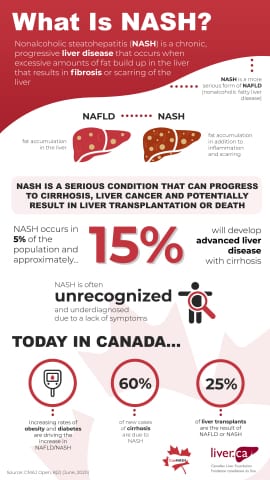In a Business Wire press release, the Canadian NASH Network (CanNASH) shared the results of a recent study predicting a severe increase in cases of nonalcoholic fatty liver disease (NAFLD) and nonalcoholic steatohepatitis (NASH) over the coming decade. The organization expects up to a 35% increase in NASH by 2030, with a 65% increase in liver-related issues. This study is the first of its kind to predict these conditions as potential Canadian health emergencies. By sharing these findings, CanNASH hopes to raise awareness on liver health. Find the study that prompted these predictions in CMAJ Open.
CanNASH Network Study
According to CanNASH, 24,400 Canadian citizens died from NASH in 2019. But by 2030, the organization expects diagnoses to increase by 35%, with deaths doubling to 49,100, accounting for 11.3% of Canada’s total deaths. More than that, the study suggests that liver failure, liver cancer, and liver transplantation will also increase by around 65%.

In addition to causing widespread health issues, this increase will result in an economic burden – both for the country and for patients. According to Jennifer Nebesky of the Canadian Liver Foundation (CLF):
“Unfortunately, the combination of obesity and diabetes within an aging population has created a ‘perfect storm’ for the progression of [NAFLD]. This is compounded by the fact that there is very little awareness about [NAFLD and NASH] among the general population.”
In fact, a survey showed that 70% of citizens had never even heard of either liver disease. As a result, patients experiencing symptoms may not know how to speak with their physicians. Alternately, physicians may fail to act towards early detection or treatment.
Moving forward, CanNASH and CLF recommend a few changes:
- Patients should enact healthy lifestyle changes (including diet and exercise) to improve their health and prevent liver damage.
- The healthcare system should create evaluation and intervention options to address the potential epidemic of NAFLD and NASH over the next decade.
- Drug and treatment development is needed to slow disease progression and address growing cases.
CanNASH and Canadian Liver Foundation
The Canadian NASH Network (CanNASH) describes themselves as a collaborative healthcare organization to develop tools, education, and research around NAFLD and NASH. One huge aim is to get Canada to recognize NAFLD as a health emergency and a major disease in need of researching.
The Canadian Liver Foundation (CLF) has been promoting education and patient advocacy for liver disease for over 51 years. The organization has a few main goals:
- Fundraising for research to determine preventative and diagnostic measures, treatments, and cures for liver disease.
- Engaging with liver disease patients and their families, as well as those at risk of developing liver disease, for advocacy and educational purposes.
- Assisting patients with understanding their condition, and connecting patients to support networks.
- Advocating for early diagnosis and treatment. Offering new resources for screening and care.
NAFLD & NASH
Nonalcoholic fatty liver disease (NAFLD), or fatty liver disease, is a condition characterized by excess fat buildup in the liver which is not caused by alcohol use. In this form, although there is fat buildup, it often doesn’t cause inflammation or damage. An estimated 30-40% of US citizens, and 30% of Canadian citizens, have NAFLD. Risk factors include obesity, Type II diabetes, and Hispanic or Asian background. With this condition, there are few symptoms. If symptoms do appear, they include abdominal pain and swelling, and fatigue. Additional symptoms may appear if the condition progresses to become NASH. Learn more about NAFLD.
Nonalcoholic steatohepatitis (NASH) is a more severe form of NAFLD. This chronic and progressive disease occurs when fat builds up in the liver of non-drinkers or those who don’t drink much. As a result, the liver becomes inflamed and covered in scar tissue, interrupting liver function. Up to 25% of American citizens, and 20% of Canadian citizens, are affected. Risk factors include obesity, high cholesterol, Type II diabetes, and metabolic syndrome.
Although NASH can be symptomatic, it is not for everyone. Symptoms might include:
- Fatigue
- Unintended weight loss
- Easy bruising and bleeding
- Jaundice (yellowing of the skin)
- Appetite loss
- Nausea and vomiting
- Abdominal pain and swelling
- Confusion or mental fuzziness
- Intense itching
- Muscle weakness
Learn more about NASH here.


